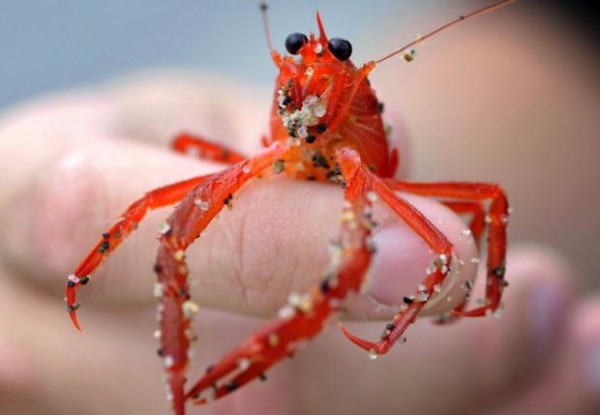Scientists Discover Swarming Red Crabs in Unusual Underwater Spot
| Ellie Froilan | | Apr 12, 2016 10:44 PM EDT |
(Photo : Reuters) The crabs are commonly known as red crabs, which are normally found around Southern California and Baja California.
A group of scientists of Hole Oceanographic Institution (WHOI) working on an ocean research trip in the coast of Panama has discovered a massive underwater swarm of crabs.
The crabs are commonly known as red crabs (Pleuroncodes planipes), which are normally found around Southern California and Baja California. Scientists said that it is the first time they have been seen so far south of their expected range, and this may be the densest swarm of crabs ever observed.
Like Us on Facebook
The crabs are a couple of inches long. They like to float up and down in the water column just to eat plankton. These red crabs also spend some of their time close to the surface and some close to the seafloor.
Led by Jesus Pineda of WHOI, the team captured the video a year ago during a month-long expedition to the Hannibal Bank Seamount off the coast of Panama. The video shows a huge number of red crabs shuffling and bobbing along the seafloor. The crabs were observed along the Northwest flank of the seamount in acidic water with very low levels of oxygen.
“When we dove down in the submarine, we noticed the water became murkier as we got closer to the bottom. There was this turbid layer, and you couldn't see a thing beyond it. We just saw this cloud but had no idea what was causing it. As we slowly moved down to the bottom of the seafloor, all of the sudden we saw these things. At first, we thought they were biogenic rocks or structures. Once we saw them moving—swarming like insects—we couldn't believe it,” Pineda said.
According to the team’s experience published in the journal PeerJ, the red crabs have dense patches and were observed previously. However, this is the first time that the patches were caught in video, ranging from 7 to 16 kilometers across. They also noted that the patches extended for tens of meters in every direction, and at its densest points there were about 77 crabs per square meter.
There are so many possibilities why these red crabs swarm on an odd location. The team suggests that the crabs interacted with each other a lot and the patches may be related to social activities like mating. They only formed the dense patch in one specific area, which might indicate that they were feeding on plankton that was abundant there.
TagsRed Crabs, underwater creatures, coast of Panama, red crabs patches
©2015 Chinatopix All rights reserved. Do not reproduce without permission
EDITOR'S PICKS
-

Did the Trump administration just announce plans for a trade war with ‘hostile’ China and Russia?
-

US Senate passes Taiwan travel bill slammed by China
-

As Yan Sihong’s family grieves, here are other Chinese students who went missing abroad. Some have never been found
-

Beijing blasts Western critics who ‘smear China’ with the term sharp power
-

China Envoy Seeks to Defuse Tensions With U.S. as a Trade War Brews
-

Singapore's Deputy PM Provides Bitcoin Vote of Confidence Amid China's Blanket Bans
-

China warns investors over risks in overseas virtual currency trading
-

Chinese government most trustworthy: survey
-

Kashima Antlers On Course For Back-To-Back Titles
MOST POPULAR
LATEST NEWS
Zhou Yongkang: China's Former Security Chief Sentenced to Life in Prison

China's former Chief of the Ministry of Public Security, Zhou Yongkang, has been given a life sentence after he was found guilty of abusing his office, bribery and deliberately ... Full Article
TRENDING STORY

China Pork Prices Expected to Stabilize As The Supplies Recover

Elephone P9000 Smartphone is now on Sale on Amazon India

There's a Big Chance Cliffhangers Won't Still Be Resolved When Grey's Anatomy Season 13 Returns

Supreme Court Ruled on Samsung vs Apple Dispute for Patent Infringement

Microsoft Surface Pro 5 Rumors and Release Date: What is the Latest?












